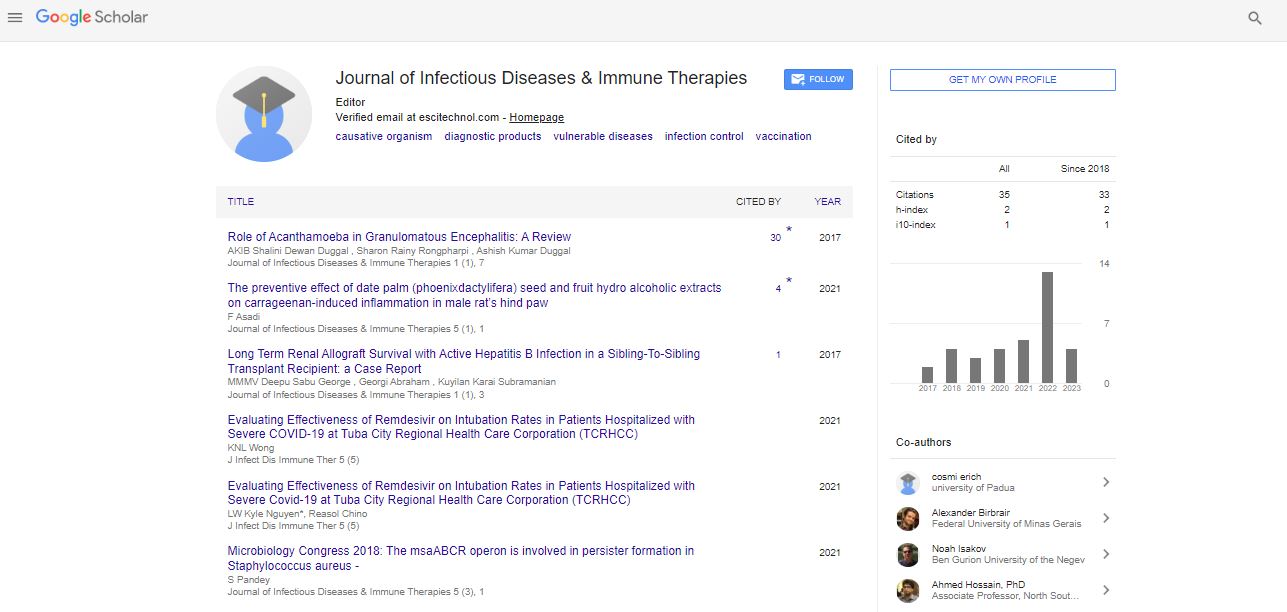Perspective, J Infect Dis Immune Ther Vol: 7 Issue: 1
Leishmaniasis: Tropical Disease with Global Health Impacts
Rosandiski Moreno*
Department of Global and Planetary Health, College of Public Health, University of South Florida, Tampa, Florida, United States of America
*Corresponding Author: Rosandiski Moreno
Department of Global and Planetary Health, College of Public Health, University of South Florida, Tampa, Florida, United States of America
E-mail: rosanmoren@usf.edu
Received date: 03 February, 2023, Manuscript No. JIDITH-23-96359;
Editor assigned date: 07 February, 2023, PreQC No. JIDITH-23-96359 (PQ);
Reviewed date: 21 February, 2023, QC No. JIDITH-23-96359;
Revised date: 28 February, 2023, Manuscript No. JIDITH-23-96359 (R);
Published date: 07 March, 2023, DOI: 10.4172/JIDITH.1000158
Citation: Moreno R (2023) Leishmaniasis: Tropical Disease with Global Health Impacts. J Infect Dis Immune Ther 7:1.
Description
Leishmaniasis is a neglected tropical disease caused by protozoan parasites of the genus Leishmania, which are transmitted to humans through the bite of infected female sandflies. It is considered one of the most important vector-borne diseases worldwide, affecting millions of people in over 98 countries across the tropics, subtropics, and some temperate regions. Leishmaniasis presents a wide range of clinical manifestations, from self-healing cutaneous lesions to severe visceral forms that can be fatal if left untreated.
Epidemiology
Leishmaniasis is endemic in regions with favorable ecological conditions for sandfly vectors, such as forests, deserts, and rural areas. The disease disproportionately affects populations living in poverty, with limited access to healthcare and inadequate housing and sanitation. According to the World Health Organization (WHO), an estimated 700,000 to 1 million new cases of Cutaneous Leishmaniasis (CL) and 20,000 to 30,000 new cases of Visceral Leishmaniasis (VL) occur each year, with a global burden of 20,000 to 30,000 deaths annually. Leishmaniasis poses a significant burden on affected communities, including economic loss, social stigma, and reduced quality of life.
Clinical manifestations
The clinical manifestations of leishmaniasis vary depending on the species of Leishmania involved, the immune status of the host, and the form of the disease. CL is the most common form of leishmaniasis and is characterized by skin lesions that may range from papules to nodules and ulcers. The lesions usually appear at the site of the sandfly bite and can take weeks to months to develop. CL can be self-healing, but in some cases, it can lead to scarring and disfigurement, especially when lesions occur on the face. VL, also known as kalaazar, is the most severe form of leishmaniasis and affects the internal organs, including the liver, spleen, and bone marrow. VL is often characterized by prolonged fever, weight loss, hepatosplenomegaly, and anemia, and if left untreated, it can be fatal.
Diagnosis
The diagnosis of leishmaniasis involves clinical suspicion, laboratory confirmation through direct visualization of parasites in tissue smears or molecular methods like PCR, and serological tests for VL, with clinical, epidemiological, and laboratory criteria used in combination for accurate diagnosis.
Treatment
The treatment of leishmaniasis depends on the form, severity, and Leishmania species involved, with various options including topical antimonials, cryotherapy, thermotherapy, systemic antimonials, amphotericin B, liposomal amphotericin B, miltefosine, pentamidine, paromomycin, and amphotericin B deoxycholate, with treatment regimens and duration varying based on region, Leishmania species, and patient's immune status.
Prevention strategies
Prevention of leishmaniasis primarily involves vector control measures, as there are no effective vaccines available, including the use of insecticide-treated bed nets, indoor residual spraying, environmental management, personal protective measures, early detection and treatment of cases, and community education and mobilization to prevent the spread of the disease.
Conclusion
Leishmaniasis is a neglected tropical disease with significant global health impacts. It affects millions of people in endemic regions, causing morbidity, mortality, and economic burden. Early diagnosis, appropriate treatment, and vector control measures are essential in controlling leishmaniasis. Health policies, surveillance, and community engagement are also essential in addressing the challenges posed by leishmaniasis and improving the health outcomes of affected populations.
 Spanish
Spanish  Chinese
Chinese  Russian
Russian  German
German  French
French  Japanese
Japanese  Portuguese
Portuguese  Hindi
Hindi 